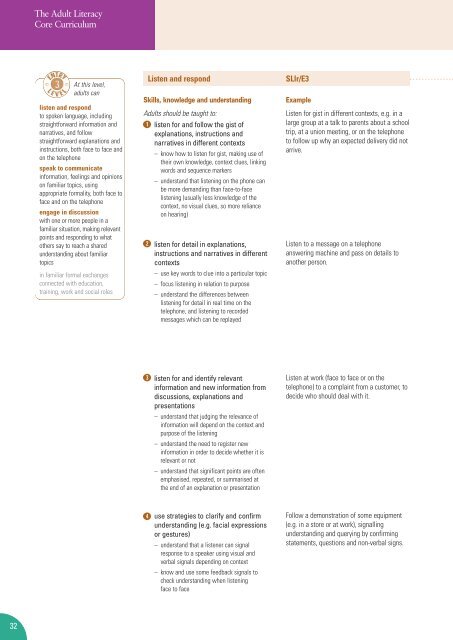Adult Literacy Core Curriculum - Nationally developed Skills for Life ...
Adult Literacy Core Curriculum - Nationally developed Skills for Life ...
Adult Literacy Core Curriculum - Nationally developed Skills for Life ...
Create successful ePaper yourself
Turn your PDF publications into a flip-book with our unique Google optimized e-Paper software.
32<br />
The <strong>Adult</strong> <strong>Literacy</strong><br />
<strong>Core</strong> <strong>Curriculum</strong><br />
At this level,<br />
adults can<br />
listen and respond<br />
to spoken language, including<br />
straight<strong>for</strong>ward in<strong>for</strong>mation and<br />
narratives, and follow<br />
straight<strong>for</strong>ward explanations and<br />
instructions, both face to face and<br />
on the telephone<br />
speak to communicate<br />
in<strong>for</strong>mation, feelings and opinions<br />
on familiar topics, using<br />
appropriate <strong>for</strong>mality, both face to<br />
face and on the telephone<br />
engage in discussion<br />
with one or more people in a<br />
familiar situation, making relevant<br />
points and responding to what<br />
others say to reach a shared<br />
understanding about familiar<br />
topics<br />
in familiar <strong>for</strong>mal exchanges<br />
connected with education,<br />
training, work and social roles<br />
<strong>Skills</strong>, knowledge and understanding<br />
<strong>Adult</strong>s should be taught to:<br />
1 listen <strong>for</strong> and follow the gist of<br />
explanations, instructions and<br />
narratives in different contexts<br />
– know how to listen <strong>for</strong> gist, making use of<br />
their own knowledge, context clues, linking<br />
words and sequence markers<br />
– understand that listening on the phone can<br />
be more demanding than face-to-face<br />
listening (usually less knowledge of the<br />
context, no visual clues, so more reliance<br />
on hearing)<br />
2<br />
3<br />
4<br />
Listen and respond SLlr/E3<br />
listen <strong>for</strong> detail in explanations,<br />
instructions and narratives in different<br />
contexts<br />
– use key words to clue into a particular topic<br />
– focus listening in relation to purpose<br />
– understand the differences between<br />
listening <strong>for</strong> detail in real time on the<br />
telephone, and listening to recorded<br />
messages which can be replayed<br />
listen <strong>for</strong> and identify relevant<br />
in<strong>for</strong>mation and new in<strong>for</strong>mation from<br />
discussions, explanations and<br />
presentations<br />
– understand that judging the relevance of<br />
in<strong>for</strong>mation will depend on the context and<br />
purpose of the listening<br />
– understand the need to register new<br />
in<strong>for</strong>mation in order to decide whether it is<br />
relevant or not<br />
– understand that significant points are often<br />
emphasised, repeated, or summarised at<br />
the end of an explanation or presentation<br />
use strategies to clarify and confirm<br />
understanding (e.g. facial expressions<br />
or gestures)<br />
– understand that a listener can signal<br />
response to a speaker using visual and<br />
verbal signals depending on context<br />
– know and use some feedback signals to<br />
check understanding when listening<br />
face to face<br />
Example<br />
Listen <strong>for</strong> gist in different contexts, e.g. in a<br />
large group at a talk to parents about a school<br />
trip, at a union meeting, or on the telephone<br />
to follow up why an expected delivery did not<br />
arrive.<br />
Listen to a message on a telephone<br />
answering machine and pass on details to<br />
another person.<br />
Listen at work (face to face or on the<br />
telephone) to a complaint from a customer, to<br />
decide who should deal with it.<br />
Follow a demonstration of some equipment<br />
(e.g. in a store or at work), signalling<br />
understanding and querying by confirming<br />
statements, questions and non-verbal signs.

















